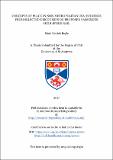Files in this item
Concepts of place in non-metropolitan USA : evidence from selected discourses on proposed passenger high-speed rail
Item metadata
| dc.contributor.advisor | Findlay, Allan M. | |
| dc.contributor.author | Boyle, Mark Patrick | |
| dc.coverage.spatial | 290 p. | en_US |
| dc.date.accessioned | 2018-07-24T15:42:48Z | |
| dc.date.available | 2018-07-24T15:42:48Z | |
| dc.date.issued | 2017 | |
| dc.identifier.uri | https://hdl.handle.net/10023/15700 | |
| dc.description.abstract | This research deepens the understanding of “sense of place” in nonmetropolitan areas in the context of the possible development of high-speed passenger-rail services in relation to three geographical dimensions: economic space, environmental concerns, and human mobility. Specifically, this qualitative research project examines how proposed passenger high-speed rail to nonmetropolitan geographies in the Midwest region of the United States affects conceptions of sense of place and space and how changes to nonmetropolitan dimensions of economics, environment, and mobility affect the sense of place and space. The United States has renewed interest in advancing passenger high-speed rail. Most research about proposed passenger high-speed rail networks in the United States have centered on the impact on major metropolitan areas of the country, but little is known about what the impact might be on smaller, nonurban and rural places along the proposed lines, much less on what they might think of it. This dissertation is intended to remedy this lack of understanding about rural place and space and how they are affected by planning for a new transportation mode such as high-speed passenger rail. The results show that a high-speed-rail network does not have to be constructed but only planned to drive changes in the conceptions of nonmetropolitan place and space. The implications affect local understandings of distribution of economic resources, social and political power, and the environment. Despite optimism about improved opportunities for accessibility and what Knowles et al. called “shrinkage of space,” concerns also include ways in which segments of the nonurban population may be further distanced and isolated. This research shows that people living in small towns and cities outside of the large metropolitan area have a continually evolving sense of themselves and their sense of place and space. Keywords: high-speed rail, planning, population geography, nonmetropolitan, rural, micropolitan, space, sense of place, social segmentation. | en |
| dc.language.iso | en | en_US |
| dc.publisher | University of St Andrews | |
| dc.subject.lcc | HE2741.B78 | |
| dc.title | Concepts of place in non-metropolitan USA : evidence from selected discourses on proposed passenger high-speed rail | en_US |
| dc.type | Thesis | en_US |
| dc.type.qualificationlevel | Doctoral | en_US |
| dc.type.qualificationname | PhD Doctor of Philosophy | en_US |
| dc.publisher.institution | The University of St Andrews | en_US |
| dc.identifier.doi | https://doi.org/10.17630/10023-15700 | en |
This item appears in the following Collection(s)
Items in the St Andrews Research Repository are protected by copyright, with all rights reserved, unless otherwise indicated.

